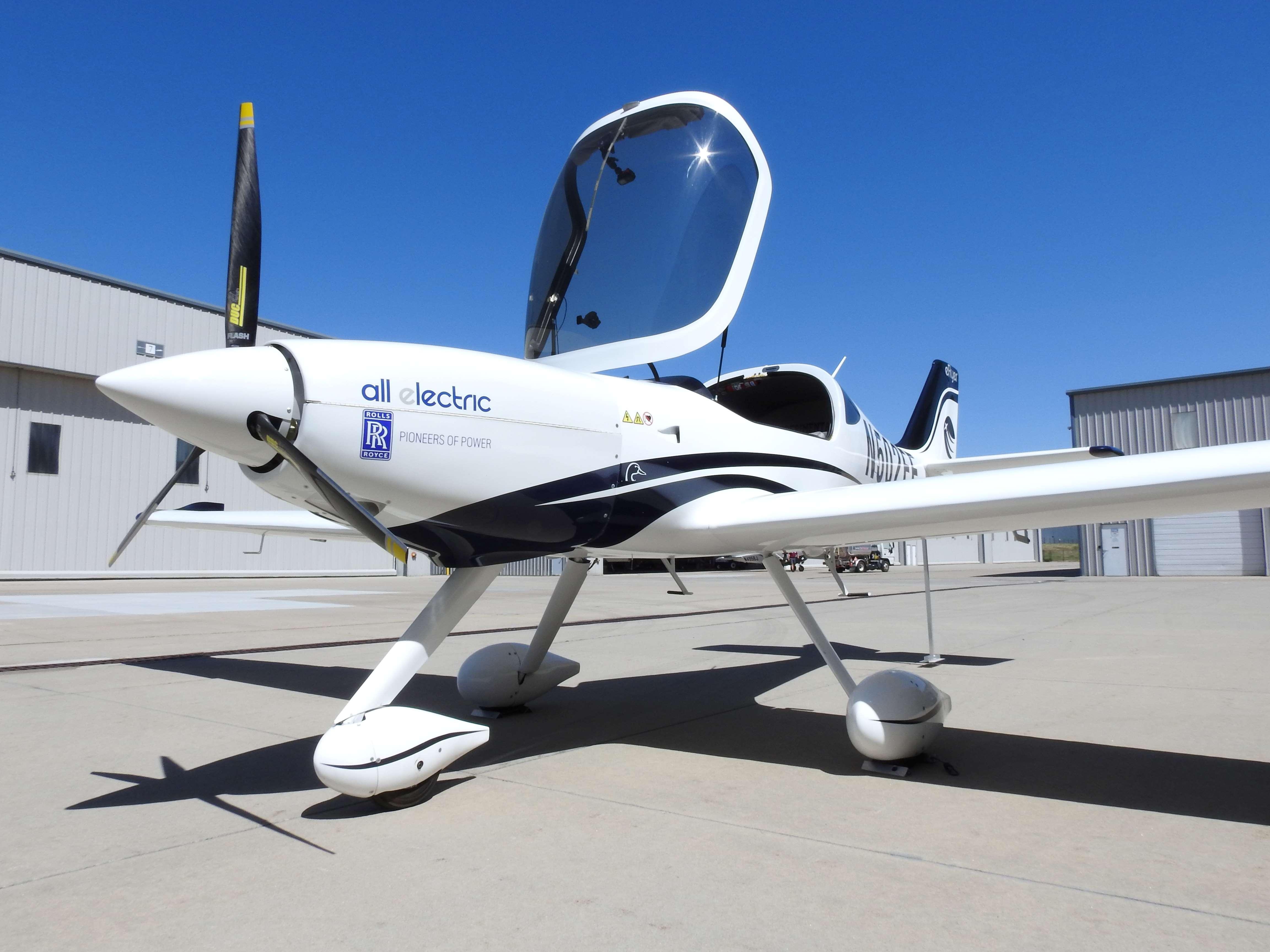Bye Aerospace is looking to advances in battery technology for future six- and nine-seat all-electric aircraft it plans will follow the two- and four-seat eFlyer 2 and 4 now in development.
The company is working with the UK’s Oxis Energy to test lithium-sulfur battery packs with higher energy density than the lithium-ion system used in the eFlyer 2 and 4. Improved battery performance is key to offering greater range in the planned eFlyer X and Envoy, CEO George Bye said in a video interview recorded for Aviation Week’s upcoming online Business Aviation Week 2020.
The eFlyer 2 is aimed at the flight school market, the two-seater optimized for typical training sorties of up to 1.3 hr. with 20-min. recharging between flights. Designed for aerodynamic efficiency to maximize performance on available batteries, the aircraft has a lift-to-drag ratio of more than 20 compared with around 10 for a Cessna 172.
From the slim nacelle enclosing the 90-kW Rolls-Royce RRP70D electric motor, the 46-in.-wide cabin, efficient 37.8-ft.-span wing and 75 kWh battery pack in the wing, to the battery management system computers and motor controller–“all those are laid out in an advantageous way,” Bye said.
The eFlyer 4 is essentially a stretch of the two-seater, sharing common aerodynamic and structural DNA, and uses the same battery technology with roughly a doubling of the pack size. “There’s a significant gross weight increase, 1,200-1,300 lb., kind of like going from a Cessna 172 to a 182 or 206,” he said.
The planned eFlyer X will fly higher and faster, a “lightly pressurized” single-motor six-seater designed to cruise at 25,000 ft. The aircraft will have retractable gear where the eFlyer 2 and 4 have fixed gear.
Illustrating an advantage of electric propulsion, Bye noted the company’s eFlyer 2 developmental prototype has the same climb rate at 9,000 ft. as at sea level. “There’s no combustion, just electrons to torque. The bottom line is electric loves to fly high and the calibrated airspeed to true airspeed benefits are fully realized–and the ability to get there, the climb rate all the way up, is not diminished.”
 Bye plans to retire its developmental testbed as it progresses toward the conforming eFlyer 2 prototype.
Bye plans to retire its developmental testbed as it progresses toward the conforming eFlyer 2 prototype.  ghe13
ghe13
 sigurjonth
sigurjonth
 andrigeir
andrigeir
 annabjorghjartardottir
annabjorghjartardottir
 ansigu
ansigu
 agbjarn
agbjarn
 armannkr
armannkr
 baldher
baldher
 h2o
h2o
 bjarnihardar
bjarnihardar
 dullur
dullur
 bjarnimax
bjarnimax
 zippo
zippo
 westurfari
westurfari
 gattin
gattin
 bryndisharalds
bryndisharalds
 eggman
eggman
 greindur
greindur
 bjartsynisflokkurinn
bjartsynisflokkurinn
 eeelle
eeelle
 sunna2
sunna2
 ea
ea
 fuf
fuf
 fhg
fhg
 vidhorf
vidhorf
 gerdurpalma112
gerdurpalma112
 gilsneggerz
gilsneggerz
 gudni-is
gudni-is
 lucas
lucas
 zumann
zumann
 gp
gp
 gun
gun
 topplistinn
topplistinn
 tilveran-i-esb
tilveran-i-esb
 skulablogg
skulablogg
 gustafskulason
gustafskulason
 gustaf
gustaf
 heimssyn
heimssyn
 diva73
diva73
 helgi-sigmunds
helgi-sigmunds
 hjaltisig
hjaltisig
 hordurhalldorsson
hordurhalldorsson
 astromix
astromix
 fun
fun
 jennystefania
jennystefania
 johanneliasson
johanneliasson
 johannvegas
johannvegas
 jonatlikristjansson
jonatlikristjansson
 fiski
fiski
 jonl
jonl
 jonmagnusson
jonmagnusson
 jonlindal
jonlindal
 bassinn
bassinn
 jonvalurjensson
jonvalurjensson
 jvj
jvj
 thjodarskutan
thjodarskutan
 juliusbearsson
juliusbearsson
 katagunn
katagunn
 kje
kje
 ksh
ksh
 kristinn-karl
kristinn-karl
 kristinnp
kristinnp
 kristjan9
kristjan9
 loftslag
loftslag
 altice
altice
 ludvikjuliusson
ludvikjuliusson
 maggij
maggij
 magnusthor
magnusthor
 omarbjarki
omarbjarki
 huldumenn
huldumenn
 svarthamar
svarthamar
 pallvil
pallvil
 peturmikli
peturmikli
 ragnarb
ragnarb
 samstada-thjodar
samstada-thjodar
 fullveldi
fullveldi
 siggus10
siggus10
 sisi
sisi
 siggisig
siggisig
 ziggi
ziggi
 siggith
siggith
 stjornlagathing
stjornlagathing
 spurs
spurs
 ubk
ubk
 valdimarjohannesson
valdimarjohannesson
 skolli
skolli
 valurstef
valurstef
 vey
vey
 postdoc
postdoc
 thjodarheidur
thjodarheidur
 icerock
icerock
 steinig
steinig
 thorsteinnhelgi
thorsteinnhelgi
 icekeiko
icekeiko
Athugasemdir
Komin hvert? Rafmagnsflugvél flaug fyrst 1973 og sólarknúin rafmagnsflugvél 2009.
Vagn (IP-tala skráð) 28.9.2020 kl. 23:41
Sagt er að Tesla sé að setja á markað rafmagnsbíl með yfir 800 km drægni og milljón km endingu. Verðið mun vera 36 þús. dalir.
Hörður Þormar (IP-tala skráð) 29.9.2020 kl. 12:07
Praktísk flugvél Vagn
Cadillac kostar hann ekki $ 50K ?Aldeilis góð tíðindi Hörður
Halldór Jónsson, 29.9.2020 kl. 13:10
Eins og er, geta rafknúnar flugvélar ekki tekið við hlutverki eldsneytisknúinna þotna yfir hafið.
Því veldur þyngd rafhlaðnanna, sem er 8-10 sinnum meiri en þyngd eldsneytis með sömu orkugeymd.
En til dæmis í Vestnannaeyjaflugi og síðar í flugi til Ísafjarðar og Akureyrar er möguleikinn fyrir hendi.
Ómar Ragnarsson, 29.9.2020 kl. 17:49
Hægri smella á myndina, smella á, open image in new tab, þá sést öll myndin.
Egilsstaðir, 01.10.2020 Jónas Gunnlaugsson
Jónas Gunnlaugsson, 1.10.2020 kl. 17:25
Bæta við athugasemd [Innskráning]
Ekki er lengur hægt að skrifa athugasemdir við færsluna, þar sem tímamörk á athugasemdir eru liðin.